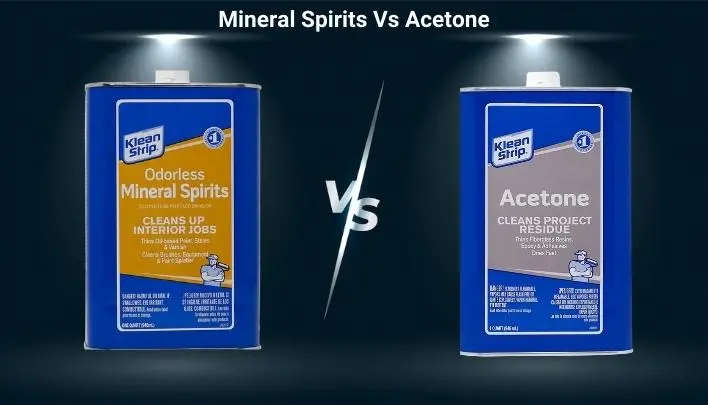Paint brushes for any artist are like magical wands they use to color the world. As a professional painter, each brushstroke, detail, and every part of a furniture painting project gives artists a way to express themselves.
The market is saturated with plenty of bushes that are made with different materials and of different types. In this article, I’ll talk about best paint brushes for furniture.
Our top pick is a 2″ Purdy XL Cub Sash Paint Brush. It is made of high quality. Its bristles are medium stiff and hold up the paint very well. It’s a great performance, and positive user reviews make it our best choice.
Table of Contents
- Our Best Furniture Paint Brushes
- Best Paint Brushes For Painting Furniture
- 1. 2″ Purdy XL Cub Sash-Best paint brushes for upcycling furniture
- 2. Jen Poly Foam-Best paint brush for staining furniture
- 3. Wooster Chinex FTP-Best paint brush for metal furniture
- 4. Richard Goose Neck-Best for trimming, ceilings and high walls
- 5. Best Dang Brush-Best paint brush for furniture chalk paint
- Removing Brush Strokes from Painted Furniture
- 1. Sand the Surface
- 2. Clean the Painted Surface
- 3. Apply a Thin Coat of Paint
- 4. Consider Leveling Additives
- 5. Finish with a Top Coat
- Brush Care: Proper Method to Clean Your Paint Brushes
- Steps to Wash Your Brushes
- Cleaning Dried up Paint
- Hanging Brushes for Proper Drying
- Final Verdict
- FAQS
- 1. How can I avoid brush marks when painting furniture?
- 2. Which is more suitable for painting furniture: a brush or a roller?
- 3. What kind of paint do most artists use on wood?
- 4. What’s the ideal brush size for woodworking projects?
- 5. How can you achieve a smooth paint finish on wood using a brush?
- Jennifer Marie
Our Best Furniture Paint Brushes
1. 2″ Purdy XL Cub Sash Paint Brush (Best for professional finish)
2. Jen Poly Foam Brush (Best for staining)
3. Wooster Chinex FTP Paintbrush (Best for VOCs-based Paints)
4. Richard Goose Neck Paint Brush (Best for tackling tight corners)
5. Dang Brush (Best for Chalk Painting)
Best Paint Brushes For Painting Furniture
You cannot buy paint brushes for every project. So, it’s best to invest in brushes that are built of good quality and go for a longer time. To save your hard-earned money, I will share my stance on the Best 5 Paint brushes you can use for furniture painting.
1. 2″ Purdy XL Cub Sash-Best paint brushes for upcycling furniture
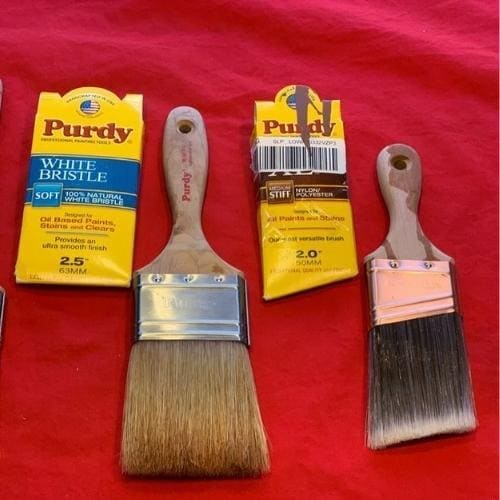
I’ve been painting for nearly 20 years, but this brush is my favorite. It has medium-stiff bristle as compared to some other ultra-stiff options.
As per my observation, this paintbrush is just the right choice when using with acrylic paints.
I really like this Purdy XL brush because it has a balanced ratio of nylon to polyester bristles. This combination ensures the brush holds up well when applying paint but retains its shape over time.
The bristles of brush are soft enough to give you a smooth finish. I usually used it to apply paint for my walls and basement ceilings. Even after some time, the painted surface look great with hardly any signs of wear. The brush has a shorter handle, which I personally prefer. It’s more comfortable to hold and control, especially for precise painting tasks.
TIP: Based on my experience, here are suggestions:
- For precision work and smaller brush size, go for the 2″ Purdy 144153320 with synthetic bristles.
- When broader coverage and a slightly larger brush are needed, choose the 2-1/2″ Purdy 144153325 with natural bristles.
Helpful resource: Which method, Spray Paint Vs. Brush Paint, is more helpful for your painting projects?
2. Jen Poly Foam-Best paint brush for staining furniture
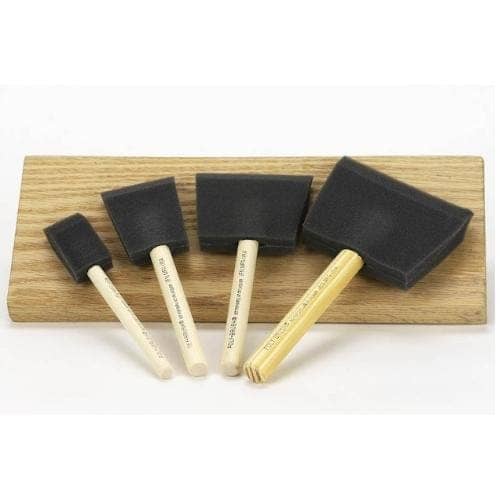
Jen Poly is a foam brush for painting furniture. I used this foam brush to refinish all my porch’s trails and support posts. Initially, I planned to use these brushes to cut around the edges, and then I would use a large bristle for large surfaces. To my surprise, they work great.
They are different from those filmy brushes with a wooden one on the top. They have a great design and a stiff material in the middle that keeps them in position. The foam is also of high quality and density. So, it reduced the risk of tearing or chucking off during the application process.
Because of the brush’s great performance, I used one 2” foam brush for the entire project. It easily stained three big wooden posts, two handrails, and all the vertical parts of the rail without wearing out.
I have read reviews of others related to haphazard packaging. But I had a positive experience as my items arrived in good condition. I must say, it is the best paint brush for smooth finish on wood.
3. Wooster Chinex FTP-Best paint brush for metal furniture

People are getting more concerned about reducing the VOCs in recent years. And the paint market is focusing on making more VOC paints. However, the problem is that low-VOC paints do not work well with nylon and polyester paint brushes. They don’t run out of their bristles very well and coagulate a bit, as shown in the image.
So, the solution is the Wooster Chinex FTP paintbrush. It works well with low-VOC paints. I used this to apply high-end oil paint for hand-brushing kitchen cabinets. It works amazingly. Its bristles move independently of the handle and pull clean, straight lines. I loved the end-fresh look it gives.
The best part is that I found this brush easier to clean than purdy paint brushes. The only problem I faced was that the logo and wrapping of the brush were quite different from the picture displayed. So, for once, I get confused thinking it is not the original.
4. Richard Goose Neck-Best for trimming, ceilings and high walls
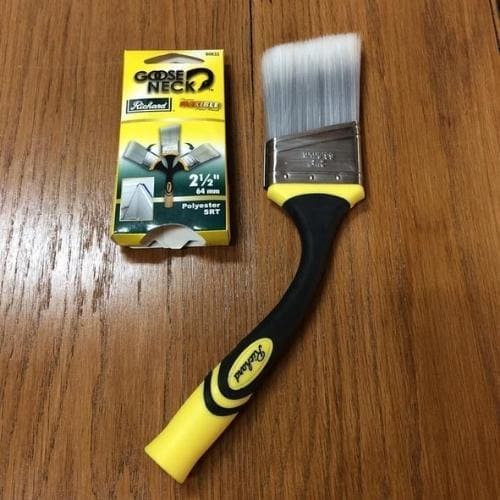
The next brush on my list is another of its type. Richard’s paint brush comes with a flexible handle. It can bend to any desired shape and be easy to paint in tight corners and tricky angles.
The synthetic fibers of the brush are also high quality. I used it to paint both latex and oil-based paints. It comes with an extension pole and was quite helpful when working on the top of my shed. The ground around the shed is uneven, which made using a ladder quite tricky. But with this brush attached to an extension pole, I could easily reach the grooves in the textured plywood, even in those rough areas. Also, I have used it while painting walls as shown in the image below;
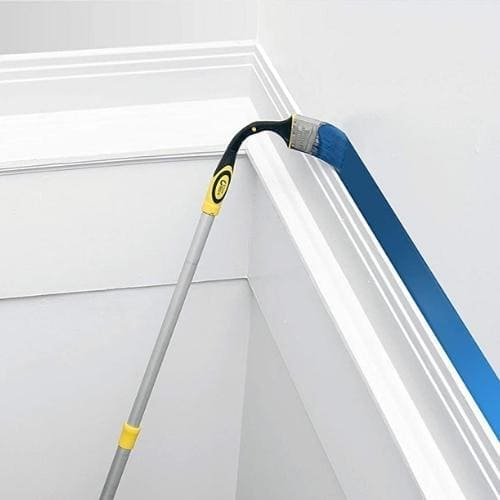
You can also buy it at Home Depot.
The only downside is that the brush bristles are too thick for cutting in. So, its quality could be improved.
5. Best Dang Brush-Best paint brush for furniture chalk paint
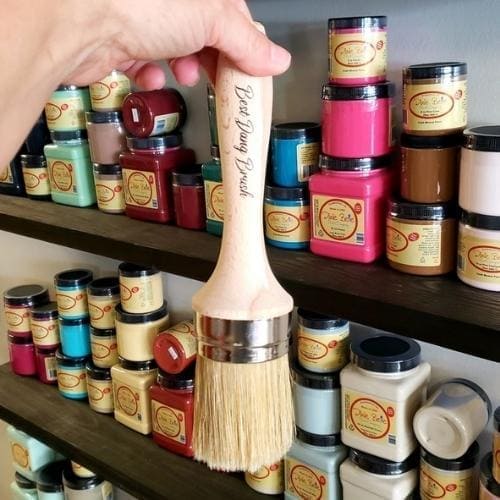
This is the quality paint brush for chalk painting furniture. The brush has a combination of synthetic and natural bristles. It is so easy to blend. The ergonomic handle provides a secure grip while painting.
Its bristles pick up and spread the paint evenly for a uniform and polished finish. This brush is a miracle for someone like me who has struggled with brush strokes and blending.I’m looking forward to seeing the remarkable results of this brush in my upcoming projects.
The only problem is its price tag because this brush is quite expensive compared to other brushes on our list.
Removing Brush Strokes from Painted Furniture
Brush strokes look bad and affect the overall look of the painted furniture. So, while painting, if you also have brush strokes on your furniture, here are steps to remove them.
1. Sand the Surface
Use 220-grit sandpaper and gently sand the surface where the brush strokes are visible. Sand in the direction of the brush strokes to make the surface as smooth as possible without removing the paint.
2. Clean the Painted Surface
Now before you start to apply paint, make sure that the surface is free of any dirt. So wipe off the sanding dust with a damp rag.
3. Apply a Thin Coat of Paint
Using a foam roller or a high-quality synthetic brush, apply a thin coat of paint over the sanded area. These tools are less likely to leave brush strokes.
4. Consider Leveling Additives
You can add a paint conditioner like Floetrol (for latex) or Penetrol (for oil-based) to help the paint level out and reduce brush marks.
5. Finish with a Top Coat
If you want a glossy finish, apply a water-based polyurethane top coat after the paint dries. Opt for a roller or foam brush to minimize more brush strokes.
Top Tip: Paint in thin layers for better results. Multiple thin coats dry faster and evenly.
Brush Care: Proper Method to Clean Your Paint Brushes
Investing in a high-quality paintbrush can be a tough decision. But don’t worry; it can last for many years with proper brush care. The key to their longevity is their proper cleaning after every project. Here is how you can do it:
Steps to Wash Your Brushes
Here are the steps you can follow to wash your paint brushes.
1. Pre-Rinse: Before applying soap, rinse as much paint or wax from your brush as possible. This step is important when dealing with heavily pigmented paints like DIY Paint.
2. Soap Application: Wet your brush and rub it onto the soap container. This creates a foamy lather.
3. Rinse: Keep rinsing your brush until it gets clean. You may need to repeat the soaping process to ensure all pigments are removed.
4. Repeat: If your brushes are caked with paint or wax, you may need to repeat the process for proper cleansing.
Cleaning Dried up Paint
If you’ve come across brushes with dried-up paint or missed spots, use fabric softener. This method can work wonders in reviving old brushes that seem beyond repair.
- Soak the brushes in a plastic cup filled with fabric softener. Leave them for about a day.
- After soaking, rinse the brushes using the same method with your chosen brush cleaner.
Pro Tip: To deal with Frizzy brush hairs, wrap it with a paper towel after cleaning while the brush is still damp. Let it sit in this position. It will help reshape and secure the bristles.
Hanging Brushes for Proper Drying
To properly dry the brushes is as important as cleaning them. So, hang them with the bristles or lay them on their sides for drying. You can also use a brush hanger. It is quite cheap and effective.
Final Verdict
Finally, finding the right paintbrush for your furniture projects can make a significant difference. With the right paintbrush, you can achieve a beautiful and professional finish. I tried to share my list of the best paintbrushes for furniture in today’s list. I tried them for many of my projects. If you get your hands on any of these brushes, share your thoughts with me. I will be happy to get suggestions from you regarding furniture painting.
FAQS
1. How can I avoid brush marks when painting furniture?
Here are a few tips that you can follow to prevent brush marks when painting furniture:
- Sand the furniture smoothly before starting.
- Use a high-quality paintbrush.
- Apply thin coats rather than a single thick one.
- Always paint in the direction of the wood grain.
- Consider using self-leveling paint.
2. Which is more suitable for painting furniture: a brush or a roller?
You can use both brush and roller for painting furniture. It depends on what you are working on. Use rollers for large, flat surfaces because they leave fewer marks and create a smooth finish. In comparison, you can use brushes for detailed work and intricate patterns.
3. What kind of paint do most artists use on wood?
Artists frequently use acrylic paints when working on wood. Acrylic paint gives versatility, quick drying time, and vibrant color payoff.
4. What’s the ideal brush size for woodworking projects?
The best brush size for woodwork often ranges between 1 to 2.5 inches. The exact size depends on the specific task. For trim and detailed work, a smaller brush is preferred. However, use a large brush for broader surfaces for better coverage.
5. How can you achieve a smooth paint finish on wood using a brush?
To get a smooth paint, finish on the wood with a brush.
- First, prep the wood surface and do its cleaning and sanding.
- Use a primer suitable for wood.
- Opt for a high-quality brush and paint.
- Apply thin and even coats.
- Sand lightly between coats for an ultra-smooth finish.

Jennifer Marie
Jennifer Marie is a general contractor with over the years of experience in home remodeling, DIY projects, and commercial painting projects. Her experience includes working with paint sprayers, painting tools, and other painting supplies. You can follow her on Facebook.

